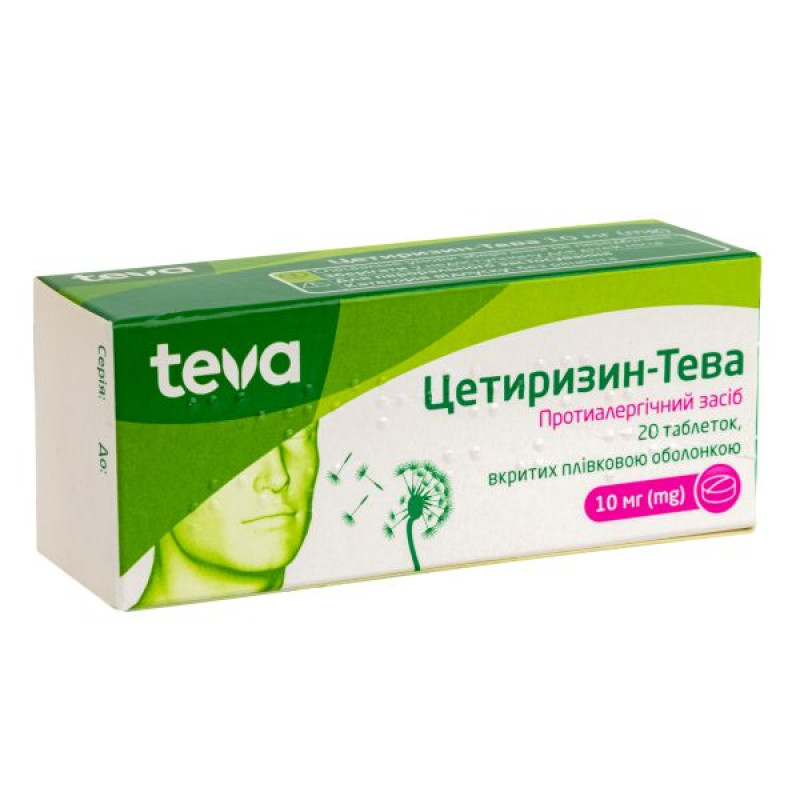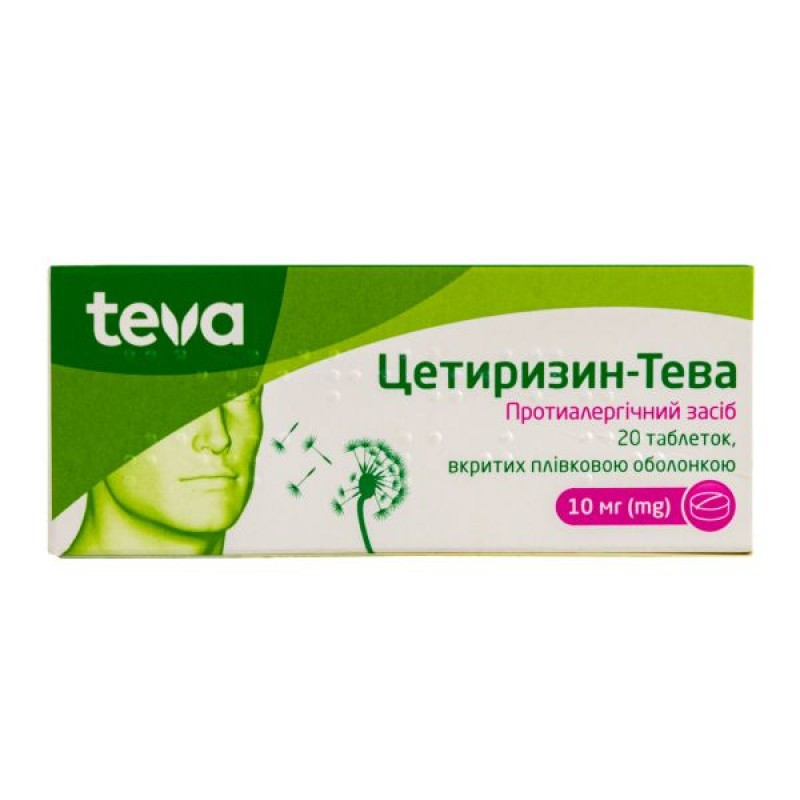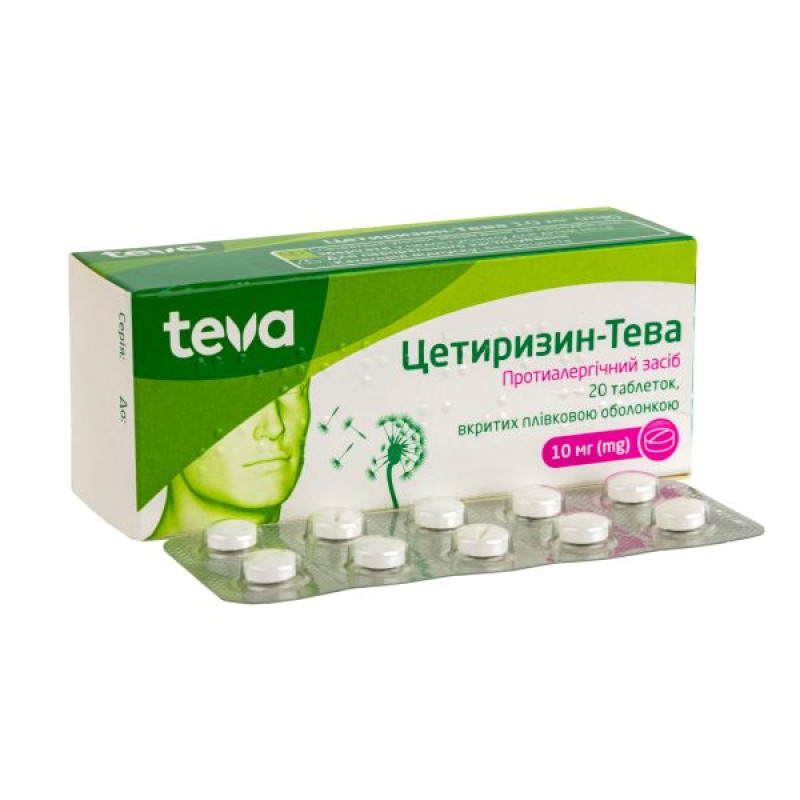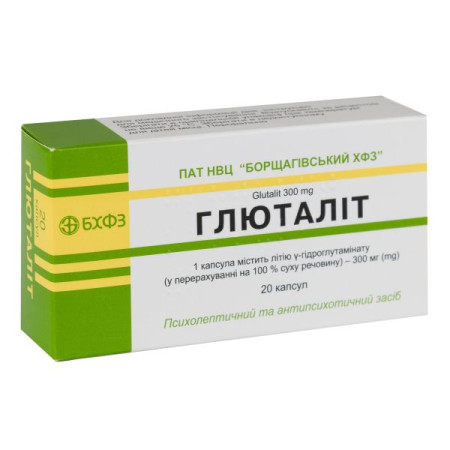Cetirizine-Teva film-coated tablets 10 mg blister No. 20

Instructions for Cetirizine-Teva film-coated tablets 10 mg blister No. 20
Composition
active ingredient: cetirizine;
1 tablet contains cetirizine dihydrochloride 10 mg;
excipients: lactose monohydrate, microcrystalline cellulose, croscarmellose sodium, colloidal anhydrous silicon dioxide, magnesium stearate;
shell (Opadry Y-1-7000): titanium dioxide (E 171), hydroxypropylmethylcellulose, macrogol 400.
Dosage form
Film-coated tablets.
Main physicochemical properties: round biconvex tablets, film-coated, white to off-white in color, with a breakline on one side.
Pharmacotherapeutic group
Antihistamines for systemic use. ATX code R06A E07.
Pharmacological properties
Pharmacodynamics
Cetirizine, a metabolite of hydroxyzine in humans, is a potent, selective antagonist of peripheral H1 receptors. In vitro receptor binding studies have shown no affinity for receptors other than H1 receptors. In addition to its antagonistic effect on H1 receptors, cetirizine has antiallergic effects: at a dose of 10 mg once or twice daily, the drug inhibits the late phase recruitment of inflammatory cells, especially eosinophils, in the skin and conjunctiva of antigen-challenged individuals, and at a dose of 30 mg/day, it inhibits the influx of eosinophils in bronchoalveolar fluid during the late phase of allergen-induced bronchoconstriction in asthmatic patients. In addition, cetirizine inhibits the late phase of the inflammatory response induced in patients with chronic urticaria by intradermal administration of kallikrein. It also reduces the expression of adhesion molecules such as ICAM-1 and VCAM-1, which are markers of allergic inflammation.
Pharmacokinetics
Cetirizine does not undergo extensive first-pass metabolism. Approximately 2/3 of the dose is excreted unchanged in the urine. The extent of absorption of cetirizine was not reduced by concomitant administration with food, although the rate of absorption was reduced. The extent of bioavailability is similar when cetirizine is administered as a solution, capsules, or tablets.
Indication
Symptomatic treatment of seasonal and perennial allergic rhinitis (symptoms such as rhinorrhea, nasal itching, sneezing), as well as non-nasal symptoms associated with conjunctivitis. Pruritus and urticaria of various types, including chronic idiopathic urticaria.
Contraindication
Hypersensitivity to cetirizine or to other components of the drug, as well as to hydroxyzine and to any piperazine derivatives in history.
Patients with severe renal impairment with creatinine clearance less than 10 ml/min.
Interaction with other medicinal products and other types of interactions
Based on the pharmacokinetics, pharmacodynamics and tolerability profile of cetirizine, any interactions with this antihistamine are unlikely. In particular, drug interaction studies have shown neither pharmacodynamic nor any significant pharmacokinetic interactions with pseudoephedrine or theophylline (400 mg/day).
In studies of cetirizine with cimetidine, glipizide, diazepam, and pseudoephedrine, there was no evidence of adverse pharmacodynamic interactions.
In studies of the use of cetirizine with antipyrine, azithromycin, erythromycin, ketoconazole, theophylline and pseudoephedrine, there was no evidence of adverse clinical interactions. In addition, the simultaneous use of cetirizine with macrolides or ketoconazole did not lead to clinically significant changes in the ECG.
There is no evidence of an increase in the effect of sedatives when cetirizine is used in therapeutic doses. However, the use of sedatives should be avoided while taking cetirizine.
The extent of absorption of cetirizine is not reduced by food, although the rate of absorption is reduced.
Application features
No clinically significant interactions with alcohol have been observed at therapeutic doses (with a blood alcohol level of 0.5 g/l). However, caution should be exercised when using this drug with concomitant alcohol consumption.
It is recommended to prescribe the drug with caution to patients who suffer from epilepsy and who may experience seizures.
Taking antihistamines can affect the results of skin tests to determine allergies, so before conducting them, you need to withstand a period of elimination of such drugs from the body (3 days).
This medicine should not be used in patients with rare hereditary problems of galactose intolerance, the Lapp lactase deficiency or glucose-galactose malabsorption.
Caution should be exercised when using the drug in patients with a tendency to urinary retention (e.g., spinal cord lesions, prostatic hyperplasia), as cetirizine may increase the risk of urinary retention.
Pruritus and/or urticaria may occur after discontinuation of cetirizine, even if these symptoms were not present before treatment. In some cases, the symptoms may be severe and may require resumption of treatment after discontinuation. These symptoms usually disappear after resumption of treatment.
Ability to influence reaction speed when driving vehicles or other mechanisms
Objective assessment of the ability to drive and use machines and the degree of drowsiness did not show any clinically significant effects when using the drug at the recommended dose of 10 mg.
Patients who drive vehicles, engage in potentially dangerous work, or operate mechanized equipment should not exceed recommended doses and should take into account their own body's response to the drug.
In sensitive patients, simultaneous administration of the drug with alcohol or other CNS depressants may cause additional impairment of attention when performing potentially hazardous tasks.
Use during pregnancy or breastfeeding
Pregnancy. There are no adequate data from the use of the drug during pregnancy. Animal studies do not indicate direct or indirect harmful effects with respect to pregnancy, embryonal/fetal development, parturition or postnatal development. The drug should be prescribed to pregnant women only if the potential benefit outweighs the potential risk to the fetus.
Breastfeeding: Cetirizine is excreted in breast milk at concentrations ranging from 25% to 90% of plasma concentrations, depending on the time after administration. Therefore, cetirizine should be used with caution in breastfeeding women.
Method of administration and doses
Take orally with 1 glass of liquid. Food intake does not affect the extent of absorption of cetirizine, although it slightly slows down this process.
Adults and children aged 6 years and over: 10 mg (1 tablet) once daily. An initial dose of 5 mg may be used if this is sufficient to control symptoms.
The course of treatment is determined by the doctor and depends on the course and duration of the disease and the individual sensitivity of the patient.
Elderly patients.
There is no need to reduce the dose for elderly patients, provided they do not have impaired renal function.
Patients with renal impairment (moderate to severe).
Dosage should be individualized based on renal function. Table 1 should be consulted and the dose adjusted accordingly. To use Table 1, the patient’s creatinine clearance (CC) in mL/min must be determined. The CC value (mL/min) can be calculated from serum creatinine (mg/dl) using the formula:
[140 – age (in years)] × body weight (kg)
CC = -------------------------------------------------- (× 0.85 for women)
72 × serum creatinine (mg/dL)
(× 0.85 for women)
Table 1. Dosage adjustments for adult patients with renal impairment
| Group | Creatinine clearance (ml/min) | Dosage and frequency |
| Normal function | ≥ 80 | 10 mg once daily |
| Mild stage of the disorder | 50-79 | 10 mg once daily |
| Moderate stage | 30-49 | 5 mg once daily |
| Severe stage | < 30 | 5 mg once every 2 days |
| End-stage renal disease – patients undergoing dialysis | < 10 | Contraindicated |
For children with impaired renal function, the dosage is adjusted individually, depending on the patient's creatinine clearance and body weight.
Patients with impaired liver function.
There is no need for dose adjustment if only liver function is impaired.
Patients with impaired liver and kidney function.
Dose adjustment is recommended (see section “Patients with renal impairment” above).
Children
The drug should be used in children over 6 years of age.
Overdose
Symptoms: Symptoms observed after overdose with cetirizine are mainly related to CNS effects or effects that may indicate anticholinergic activity. Adverse reactions reported after doses exceeding at least 5 times the recommended daily dose include: confusion, diarrhea, dizziness, fatigue, headache, malaise, mydriasis, pruritus, restlessness, sedation, drowsiness, stupor, tachycardia, tremor, urinary retention.
Treatment. There is no specific antidote for cetirizine. In case of overdose, symptomatic and supportive therapy is recommended. Gastric lavage should be performed as soon as possible after ingestion. Cetirizine is ineffectively removed by dialysis.
Adverse reactions
Clinical studies have shown that cetirizine, when used at recommended doses, has minor adverse effects on the central nervous system, including drowsiness, fatigue, dizziness and headache. In some cases, paradoxical CNS stimulation has been reported.
Although cetirizine is a selective antagonist of peripheral H1 receptors and has almost no anticholinergic effect, isolated cases of difficulty urinating, impaired eye accommodation, and dry mouth have been reported.
Cases of liver dysfunction characterized by elevated liver enzymes accompanied by elevated bilirubin have been reported. The condition usually resolved after discontinuation of the drug.
There are data on the safety of cetirizine in more than 3200 subjects who participated in double-blind controlled trials comparing cetirizine with placebo or other antihistamines at the recommended dose (10 mg cetirizine daily).
Summarizing these data, adverse events were reported with cetirizine 10 mg at an incidence of 1.0% or greater in placebo-controlled studies (Table 2).
Table 2
Side effect (WHO adverse reaction terminology) | Cetirizine (n = 3260) | Placebo (n = 3061) |
The body as a whole – general disorders Fatigue | 1.63% | 0.95% |
From the central and peripheral nervous system Dizziness Headache | 1.10% 7.42% | 0.98% 8.07% |
Gastrointestinal tract Stomach pain Dry mouth Nausea | 0.98% 2.09% 1.07% | 1.08% 0.82% 1.14% |
From the psyche Drowsiness | 9.63% | 5.00% |
Respiratory tract Pharyngitis | 1.29% | 1.34 |
Although drowsiness occurred statistically more frequently than in the placebo group, most of the cases were mild to moderate. As in other studies, the results of objective studies confirmed that taking the recommended daily dose does not cause a negative impact on daily activities in healthy subjects.
Table 3. Adverse reactions with an incidence of 1% or more in children aged 6 months to 12 years during placebo-controlled clinical trials
Side effect (WHO adverse reaction terminology) | Cetirizine (n = 1656) | Placebo (n = 1294) |
Gastrointestinal tract Diarrhea | 1.0% | 0.6% |
From the psyche Drowsiness | 1.8% | 1.4% |
Respiratory tract Rhinitis | 1.4% | 1.1% |
The body as a whole – general disorders Fatigue | 1.0% | 0.3% |
Post-marketing surveillance
In addition to the adverse reactions reported in clinical trials listed above, the following adverse reactions have been reported during post-marketing experience.
Adverse reactions reported during post-marketing experience are listed below by MedDRA system organ class and frequency.
The frequency of occurrence is defined as follows: uncommon (≥ 1/1000 and < 1/100), rare (≥ 1/10,000 and < 1/1000), very rare (< 1/10,000), not known (frequency cannot be estimated from the available data).
Blood and lymphatic system disorders
Very rare: thrombocytopenia.
On the part of the immune system
Rare: hypersensitivity.
Very rare: anaphylactic shock.
Metabolism and nutrition
Frequency unknown: increased appetite.
From the psyche
Uncommon: agitation.
Rare: aggression, confusion, depression, hallucinations, insomnia.
Very rare: nervous tic.
Frequency unknown: suicidal thoughts.
From the nervous system
Uncommon: paraesthesia.
Rare: convulsions.
Very rare: dysgeusia, syncope, tremor, dystonia, dyskinesia.
Frequency unknown: amnesia, memory impairment.
From the organs of vision
Very rare: accommodation disorder, blurred vision, involuntary eye movements.
From the hearing organs
Frequency unknown: vertigo.
From the heart
Rare: tachycardia.
Gastrointestinal tract
Uncommon: diarrhoea.
Hepatobiliary system
Rare: liver function abnormalities (increased transaminases, alkaline phosphatase, GGTP and bilirubin).
Skin and subcutaneous tissue disorders
Uncommon: itching, rash.
Rare: urticaria.
Very rare: angioedema, persistent erythema drug-induced.
Frequency unknown: acute generalized exanthematous pustulosis.
From the urinary system
Very rare: dysuria, enuresis.
Frequency unknown: urinary retention.
General disorders and administration-related disorders
Uncommon: asthenia, malaise.
Rare: edema.
Laboratory studies
Rare: weight gain.
Description of selected adverse reactions
Pruritus (severe itching) and/or urticaria have been reported after discontinuation of cetirizine.
Expiration date
3 years.
Storage conditions
No special storage conditions are required. Keep out of the reach of children.
Packaging
7 tablets in a blister, 1 blister in a box.
Vacation category
Without a prescription.
Producer
Merkle GmbH.
Location of the manufacturer and its business address
Ludwig-Merkle-Strasse 3, 89143 Blaubeuren, Germany.
There are no reviews for this product.
There are no reviews for this product, be the first to leave your review.
No questions about this product, be the first and ask your question.















